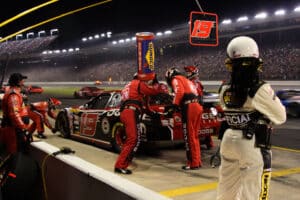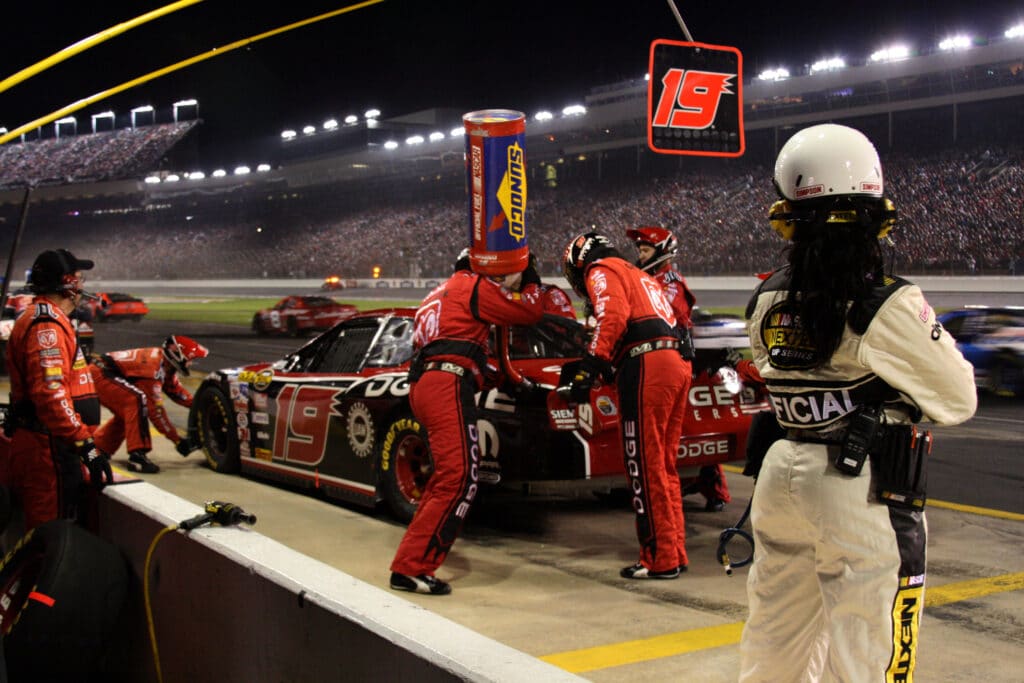No products in the cart.
Fun Facts
The Importance of Pit Strategy: Breaking Down Pit Stops and Tire Strategy at Homestead-Miami Speedway
 The Importance of Pit Strategy: Breaking Down Pit Stops and Tire Strategy at Homestead-Miami Speedway
The Importance of Pit Strategy: Breaking Down Pit Stops and Tire Strategy at Homestead-Miami Speedway
Racing isn’t just about speed; it’s about strategy, timing, and making decisions in high-pressure situations. Nowhere is this more evident than at Homestead-Miami Speedway, a track that challenges drivers and teams alike. One of the most crucial elements determining a race’s outcome is pit strategy—specifically, when and how teams manage pit stops and tire changes. In a sport where hundredths of a second can be the difference between victory and defeat, understanding the nuances of pit strategy is key.
Introduction to Pit Strategy
Pit strategy, in simple terms, refers to a team’s approach to managing their stops during a race—whether it’s for fuel, tires, or adjustments to the car’s setup. This isn’t something teams wing as the race unfolds; it’s a premeditated plan based on data, experience, and real-time adjustments as the race progresses. Every decision made in the pit lane affects how a race plays out. At Homestead, with its abrasive track surface and unpredictable weather, these decisions are even more amplified. A well-executed pit stop could be the difference between a driver crossing the finish line first or falling to the back of the pack.
Homestead as a Unique Challenge
Homestead-Miami Speedway presents an array of unique challenges that make pit strategy even more critical. This 1.5-mile oval with progressive banking offers drivers multiple racing lines, but it also chews up tires faster than most tracks. Combine that with unpredictable weather conditions—typical of South Florida—and you’ve got a recipe for high-pressure decision-making.
Understanding the Track Layout
The progressive banking at Homestead means drivers can take different lines depending on tire wear and car setup. This variability in approach places extra importance on tire strategy, as different parts of the track will wear out tires at different rates. Teams need to keep a close eye on how their car is performing throughout the race and adjust accordingly.
Weather and Its Impact
If you’ve ever spent time in Florida, you know the weather can change in an instant. Homestead is no exception. One minute, the track could be roasting in the sun, causing the surface to become slick and reducing grip. The next, a rain shower could cool things down, suddenly making tires more effective. Teams have to remain flexible, adjusting their pit strategies to fit the changing weather conditions.
The Role of Pit Stops in Racing
Pit stops aren’t just a necessary evil—they’re a strategic weapon. While drivers race around the track at speeds exceeding 200 mph, their teams in the pits are preparing for quick, decisive action. A pit stop is more than just changing tires or refueling; it’s a chance to make minor adjustments, refuel, and keep the car at peak performance.
Timing Is Everything
One of the toughest calls a team has to make is when to pit. Too early, and you may lose track position to cars running longer. Too late, and your tires might wear out, slowing you down. The perfect pit stop is a balance between maintaining speed on the track and getting fresh tires or fuel at the right time. At Homestead, where tire wear is particularly high, these decisions can make or break a race.
Gaining or Losing Positions in the Pits
Pit stops are often where races are won or lost. A well-timed stop with a fast tire change can catapult a driver past competitors. Conversely, a slow stop—due to mistakes like a stuck lug nut or a fuel issue—can cost valuable track positions. Homestead’s abrasive surface makes this even more critical, as fresh tires can offer a significant advantage over worn ones.
Tire Strategy at Homestead
Tires are the unsung heroes of any race, and at Homestead, they take a beating. The rough surface wears down tires quickly, meaning teams have to be smart about when to change them and which compound to use. Tire strategy involves balancing the short-term gain of soft, grippy tires with the long-term advantage of harder, more durable ones.
Tire Wear on Homestead’s Abrasive Surface
Homestead’s rough asphalt eats through tires faster than a hot knife through butter. Over the course of a green-flag run, tires lose grip, forcing drivers to manage their pace carefully. A driver on old tires will find it increasingly difficult to keep up with those on fresher rubber, so pit stops need to be timed perfectly to take advantage of tire wear.
Soft vs. Hard Compound Tires
In some racing series, teams can choose between soft and hard tire compounds. Soft tires offer more grip but wear out faster, while hard tires last longer but don’t provide as much traction. Teams have to weigh the benefits of better grip against the risk of needing more frequent pit stops. At Homestead, with its combination of long runs and sudden caution periods, this decision is a constant balancing act.
Long Runs vs. Short Runs
Homestead often sees long green-flag runs, which put extra strain on tires. However, caution periods—where the field slows down under a yellow flag—can bunch up the pack and create short sprints to the finish. Teams must adjust their tire strategy to match the race’s flow, ensuring they have enough tire life left for a late-race push if needed.
Fuel Strategy: The Unsung Hero
While tire strategy often gets all the attention, fuel strategy plays a quietly crucial role in determining race outcomes. Teams must balance pushing hard for speed with conserving enough fuel to avoid an extra pit stop.
Balancing Speed and Conservation
Fuel strategy isn’t just about filling the tank; it’s about maximizing efficiency. Teams need to decide when to push for speed and when to conserve fuel to stretch a run. At Homestead, where the race can shift from long green-flag runs to a sudden sprint, balancing speed with fuel conservation can be the difference between winning and running out of gas.
The Impact of Caution Periods on Fuel Strategy
Caution periods can throw a wrench into the best-laid plans. A caution near the end of a race can give teams the chance to pit for fuel and tires, while others may gamble on staying out and saving track position. Teams that can adjust their fuel strategy in real-time often gain an edge over those that stick rigidly to their pre-race plans.
How Teams Adapt to Real-Time Data
In modern racing, teams have access to a wealth of real-time data. Every lap, telemetry from the car provides information on tire wear, fuel levels, engine performance, and more. Teams use this data to make split-second decisions, adjusting their strategy as the race unfolds.
Communicating with the Driver
Clear communication between the driver and the pit crew is essential. Drivers give feedback on how the car feels, while the crew provides updates on lap times, tire wear, and fuel consumption. This constant back-and-forth allows teams to make informed decisions about when to pit and what adjustments to make.
Using Telemetry for Strategy Adjustments
Telemetry is the backbone of modern pit strategy. Sensors on the car relay information to the pit wall, allowing engineers to monitor tire wear, engine performance, and even brake temperatures. Armed with this data, teams can adjust their pit strategy on the fly, ensuring the car is always in the best shape possible for the next stint.
Key Examples of Successful Pit Strategies at Homestead
Over the years, Homestead has seen some memorable races where pit strategy played a pivotal role in determining the outcome. Whether it’s a last-lap tire gamble or a perfectly timed fuel stop, the teams that master pit strategy often find themselves in victory lane.
Memorable Race Finishes Decided by Pit Strategy
In one memorable race, a team gambled on staying out during a late caution, opting not to pit for fresh tires. While their competitors dived into the pits, they held onto track position and managed to fend off challengers on newer tires. It was a risky move, but it paid off, and they crossed the finish line first.
Lessons Learned from Pit Strategy Failures
For every success story, there’s a cautionary tale. Teams that misjudge tire wear or mistime a pit stop can see their race unravel in an instant. At Homestead, with its tricky conditions and high tire wear, even the smallest mistake in the pits can have significant consequences.
The Role of Teamwork in the Pit Crew
A driver is only as good as their pit crew. The men and women in the pits work tirelessly to ensure every stop is fast, efficient, and error-free. The importance of teamwork cannot be overstated; a perfectly choreographed pit stop can gain a driver valuable track position, while a mistake can cost them the race.



